کامپیوتر اودروید +ODROID-C1
+ODROID-C1
+ODROID-C1 به عنوان قوی ترین رایانه تک بورد ارزان قیمت موجود است و همچنین یک دستگاه بسیار متنوع است. مجهز به پردازنده چهار هسته ای Amlogic ، پردازنده گرافیکی پیشرفته مالی و Gigabit Ethernet ، می تواند به عنوان یک مجموعه خانگی سینمای خانگی ، یک رایانه عمومی برای وبگردی ، بازی و معاشرت ، یک ابزار جمع و جور برای کارهای دانشگاهی یا اداری عمل کند. نمونه سازی دستگاه برای خرابی سخت افزار ، کنترل کننده اتوماسیون خانگی ، ایستگاه کاری برای توسعه نرم افزار و موارد دیگر.
برخی از سیستم عامل های مدرن که بر روی ODROID-C1 + اجرا می شوند عبارتند از Ubuntu ، Android ، Fedora ، Arch Linux ، Debian و LibreELEC ، با هزاران بسته نرم افزاری منبع باز رایگان. ODROID-C1 + یک دستگاه ARM است-پرکاربردترین معماری برای دستگاه های تلفن همراه و محاسبه 32 بیتی تعبیه شده است. اندازه کوچک پردازنده ARM ، پیچیدگی کمتر و مصرف کم انرژی ، آن را برای دستگاه های مینیاتوری مانند پوشیدنی ها و کنترل های تعبیه شده بسیار مناسب می کند.
* CPU های چهار هسته ای Amlogic ARM® Cortex®-A5 (ARMv7) 1.5Ghz
* GPU Mali -450 MP2 (OpenGL ES 2.0 / 1.1 فعال برای لینوکس و اندروید)
* 1 گیگابایت DDR3 SDRAM
* اترنت گیگابیت
* GPIO های 40 پین + I2S 7 پین
* اسلات حافظه فلش eMMC4.5 HS200 / کارت حافظه MicroSD UHS-1 SDR50
* USB 2.0 میزبان x 4 ، USB OTG x 1 (قدرت + قابلیت داده)
* گیرنده مادون قرمز (IR)
* سیستم عامل اوبونتو یا Android
به دلیل تغییرات فوق ، موارد اصلی و سینک های حرارتی سازگار نیستند.
Computer ODROID-C1+
ODROID-C1+
The ODROID-C1 + is esteemed to be the most powerful low-cost single board computer available, as well as being an extremely versatile device. Featuring a quad-core Amlogic processor, advanced Mali GPU, and Gigabit Ethernet, it can function as a home theater set-top box, a general purpose computer for web browsing, gaming and socializing, a compact tool for college or office work, a prototyping device for hardware tinkering, a controller for home automation, a workstation for software development, and much more.
Some of the modern operating systems that run on the ODROID-C1 + are Ubuntu, Android, Fedora, Arch Linux, Debian, and LibreELEC, with thousands of free open-source software packages available. The ODROID-C1 + is an ARM device – the most widely used architecture for mobile devices and embedded 32-bit computing. The ARM processor’s small size, reduced complexity and low power consumption makes it very suitable for miniaturized devices such as wearables and embedded controllers.
* Amlogic ARM® Cortex®-A5 (ARMv7) 1.5Ghz quad core CPUs
* Mali ™ -450 MP2 GPU (OpenGL ES 2.0 / 1.1 enabled for Linux and Android)
* 1Gbyte DDR3 SDRAM
* Gigabit Ethernet
* 40pin GPIOs + 7pin I2S
* eMMC4.5 HS200 Flash Storage slot / UHS-1 SDR50 MicroSD Card slot
* USB 2.0 Host x 4, USB OTG x 1 (power + data capable)
* Infrared (IR) Receiver
* Ubuntu or Android OS
Because of the above changes, the original cases and heat sinks are not compatible.
An SD 3.01 standard compatible UHS-1 Micro-SD card, as well as the faster eMMC module, can be ordered with the ODROID-C1, and arrives with the popular Ubuntu operating system already installed. Insert the SD card into the slot, connect a monitor, a keyboard, a mouse, Ethernet and power cable, and that’s all you need to do to use the ODROID-C1! Browse the web, play games, run office programs, edit photos, develop software, and watch videos right away.
The RTC, IR receiver and ADC features on the ODROID-C1 offer many options for building great DIY projects
| ODROID-C1 | RPi 2 Model B | |
| CPU |
Amlogic S805 SoC
4 x ARM® Cortex®-A5 1.5GHz
ARMv7 Architecture @28nm
|
Broadcom BCM2836
4 x ARM® Cortex®-A7 900Mhz
ARMv7 Architecture @40nm
|
| GPU | 2 x ARM® Mali™-450MP 600MHz | 1 x VideoCore IV 250MHz |
| RAM | 1GB 32bit DDR3 792MHz | 1GB 32bit LP-DDR2 400MHz |
| Flash Storage | Micro-SD UHS-1@100Mhz/SDR50 or eMMC storage option | Micro-SD @50Mhz/SDR25, No eMMC storage option |
| USB2.0 Host | 4 Ports | 4 Ports |
| USB2.0 Device / OTG | 1 Port for Linux USB Gadget driver | No |
| Ethernet/LAN | 10/100/1000 Mbit/s | 10/100 Mbit/s |
| Video Output | HDMI | HDMI / Composite RCA |
| Audio Output | HDMI | HDMI / 3.5mm Jack |
| Camera Input | USB 720p | MIPI CSI 1080p |
| Real Time Clock | YES (On-board RTC) | No(unless using an add-on module) |
| IR Receiver | YES (On-board IR Sensor) | No(unless using an add-on module) |
| IO Expansion | 40pin port (GPIO/UART/SPI/I2C/ADC) | 40pin port (GPIO/UART/SPI/I2C/I2S) |
| ADC | 10bit SAR 2 channels | No(unless using an add-on board) |
| Size | 85 x 56mm (3.35” x 2.2”) | 85 x 56mm (3.35” x 2.2”) |
| Weight | 40g (1.41 oz) | 42g (1.48 oz) |
| Price | $35 | $35 |
Computing performance comparison
We ran a simple, popular benchmark called Unix-Bench, SysBench and N-Bench to compare the performance of the two boards. Tests were done using several manufacturer-provided images based on a clean install, and the “apt-get update && apt-get upgrade” commands were first run to ensure that both boards was up-to-date.The RPi2 was clocked at 900Mhz using a Sandisk UHS-1 8GB SDCard running the Raspbian OS. The C1 was clocked at 1.5Ghz using an 16GB eMMC with Ubuntu 14.04 OS. Both units were powered by a 5V/2A power supply and connected to the 1920×1080 HDMI output.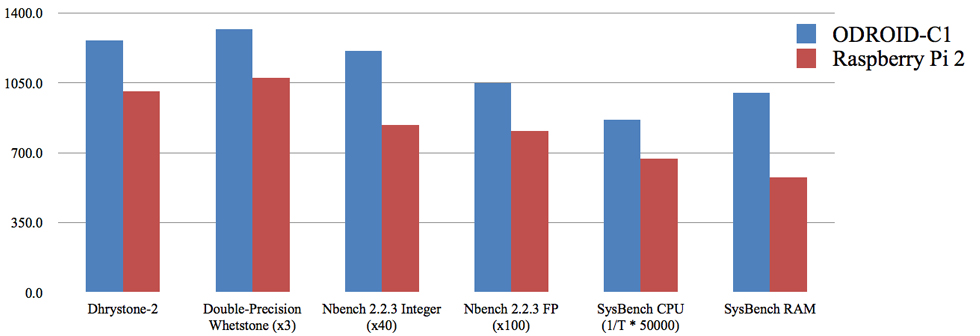

| Benchmarks(Index Score) | ODROID-C1 | Raspberry Pi 2 | Ratio |
| Dhrystone-2 | 1262.8 | 1006.6 | 1.25 |
| Double-Precision Whetstone (x3) | 1318.8 | 1076.1 | 1.23 |
| Nbench2.2.3 Integer ( x40) | 1208.0 | 840.0 | 1.44 |
| Nbench2.2.3 | 1050.0 | 809.0 | 1.30 |
| SysBench CPU ( 1/T * 50000) | 863.6 | 669.3 | 1.29 |
| SysBench RAM | 998.3 | 574.7 | 1.74 |
The results show that the CPU computing benchmark is about 30% faster on the C1 and RAM memory access speed is about 75% faster on the C1.
Note that above benchmark scores were converted to make an easier comparison.
Storage I/O comparison To obtain the results in the storage I/O comparison graph, type the following lines at a command prompt. The first command tests the write speed, and the second command tests the read speed:$ dd if=/dev/zero of=test.tmp oflag=direct bs=500K count=1024 $ dd if=test.tmp of=/dev/null iflag=direct bs=500K count=1024
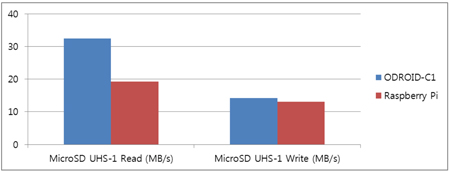  |
|
If you use the eMMC storage, you can get about two to three times faster storage I/O read performance. However, an affordable microSD UHS-1 card can still achieve reasonably fast speeds thanks to the advanced SD 3.01 host controller in the S805 processor. The MicroSD card read performance on C1 is still about 1.7 times faster then RPi if you use the UHS-1 memory card.
Ethernet IO comparisonTo replicate the results in the Ethernet comparison graph, type the following lines at a command prompt: Server agent on the C1 and Client agent on the host PC ruppi@ruppi-desktop:~$ iperf -s 192.168.2.10 -P 10 [SUM] 0.0-10.1 sec 1.10 GBytes 928 Mbits/secServer agent on the host PC and Client agent on the C1 odroid@odroid:~# iperf -c 192.168.2.2 -P 10 [SUM] 0.0-10.0 sec 467 MBytes 392 Mbits/secServer agent on the RPi and Client agent on the host PC ruppi@ruppi-desktop:~$ iperf -c 192.168.2.11 -P 10 [SUM] 0.0-10.3 sec 121 MBytes 98.6 Mbits/sec Server agent on the host PC and Client agent on the RPi pi@raspberrypi:~$ iperf -s 192.168.2.2 -P 10 [SUM] 0.0-10.3 sec 81.6 MBytes 66.6 Mbits/secThanks to the Gigabit Ethernet available on the ODROID-C1, the network performance of C1 is an impressive six to nine times faster than Raspberry Pi. |
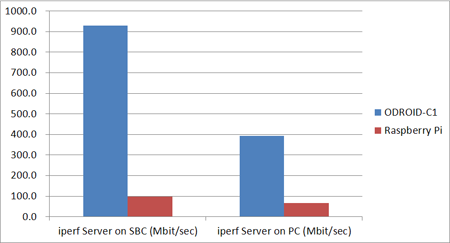  |
As one can see from the testing results, the quad-core 1.5GHz ODROID-C1 can easily outperform the Raspberry Pi 2 board. Many test results show about 140% more performance from the ODROID-C1 platform. Even though both platforms are Linux-friendly computing devices, the performance to cost ratio is much higher with the ODROID-C1. If you are considering a tiny computer for general purpose computing, software development, or as a project platform, the ODROID-C1 will give you a lot more satisfaction and fun with incredible performance for a very low price.
| Processor | Amlogic S805 SoC ARM® Cortex®-A5 (ARMv7) 1.5GHz Quad Core ARMv7 architecture @28nm wafer |
| Memory | 1Gbyte DDR3 RAM 792Mhz |
| 3D Accelerator | ARM® Mali™-450 MP2 OpenGL ES 2.0 / 1.1 |
| Flash Storage | eMMC Module Socket : eMMC module (option) MicroSD Card Slot : 8 or 16GB MicroSD UHS-1 (option) |
| USB2.0 Host | High speed standard A type connector x 4 ports |
| USB2.0 Device/OTG | High Speed USB standard A type connector x 1 port |
| Ethernet/LAN | 10/100/1000Mbps Ethernet with RJ-45 Jack (Auto-MDIX support) |
| Video Output | HDMI |
| Audio Output | HDMI |
| Camera Input | USB 720p(option) |
| Real Time Clock | On-board RTC function with a backup battery connector |
| IO Expansion | 40pins |
| WiFi | USB IEEE 802.11b/g/n 1T1R WLAN with Antenna (USB module) (option) |
| Power | 5V 2A Power (option) |
| System Software | Ubuntu 14.04 + OpenGL ES on Kernel 3.10 LTS Android 4.4.x on Kernel 3.10 LTS Full source code is accessible via our Github. |
| PCB Size | 85 x 56 x 18 mm approx. (Weight : 40 gram) PCB Thickness : 1.0mm |

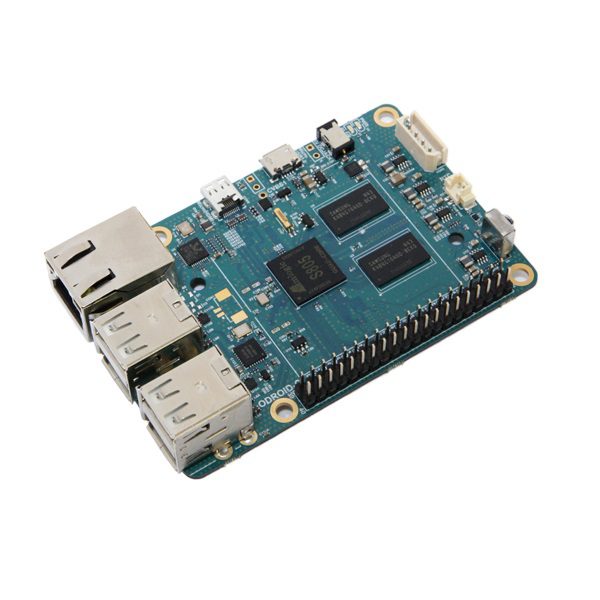
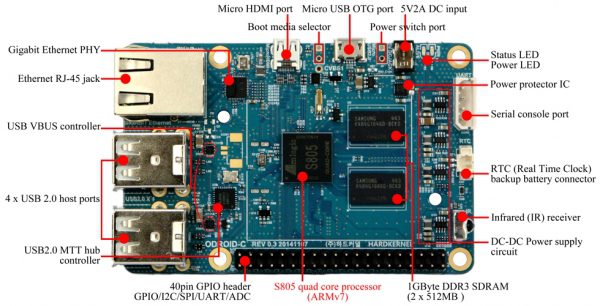
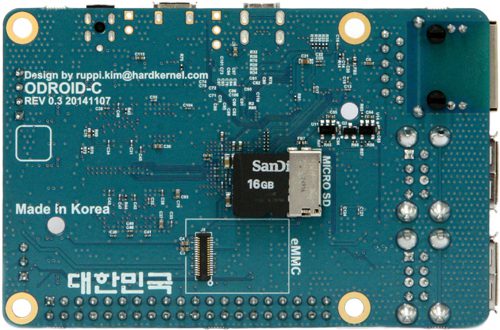

دیدگاهها
هیچ دیدگاهی برای این محصول نوشته نشده است.